| 1 | Common garter snake |
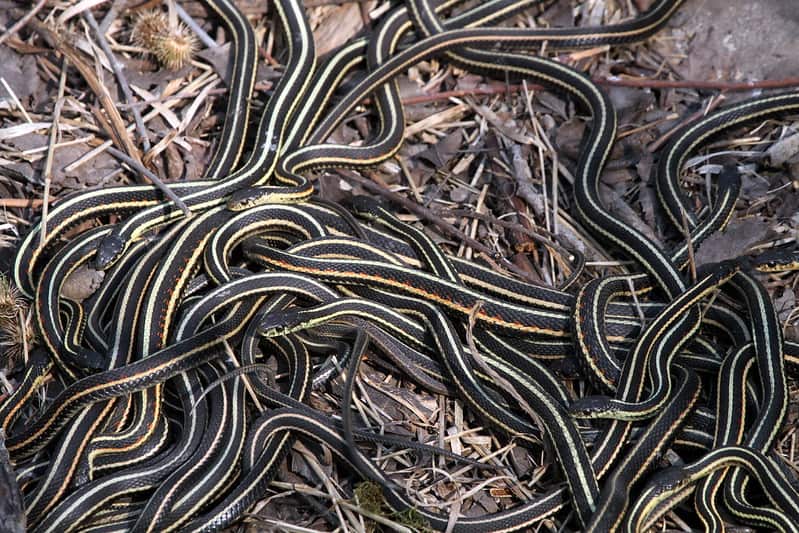
Maximum length: 137.2cm.
Garter snakes are easily the most social snake family of all. This is partly because they live further north, making it wise to huddle together and share body heat. From October, thousands can gather at once, never biting or snapping at each other.
In the south, the garter snake’s hibernations sites are simpler, like a rotting log or rock pile. But in Canada or Maine, it’s vital that they’re below the frost line, and optimal sites are rarer – hence why they all end up in the same place. Common garter snakes (Thamnophis sirtalis) can slither up to a mile to return to winter hibernation sites they’re familiar with. They can become a pulsating, writhing snake mass, like a northerly version of an Egyptian tomb. The species also breeds while in these communal gatherings, sometimes with so many males jumping on a single female that she gets crushed and dies.
Common garter snakes can hibernate in vast numbers in caves, beneath railways, or in the foundations of houses. In their coldest territories, the numbers can be colossal. One red-sided garter snake (a subspecies) den in the Interlake region of Manitoba contained over 20,000 snakes. This den was a 15 metre deep sinkhole, the former limestone roof of an underground stream, which had collapsed to allow the garter snake swarms access to the caverns below.
| 2 | Prairie rattlesnake |
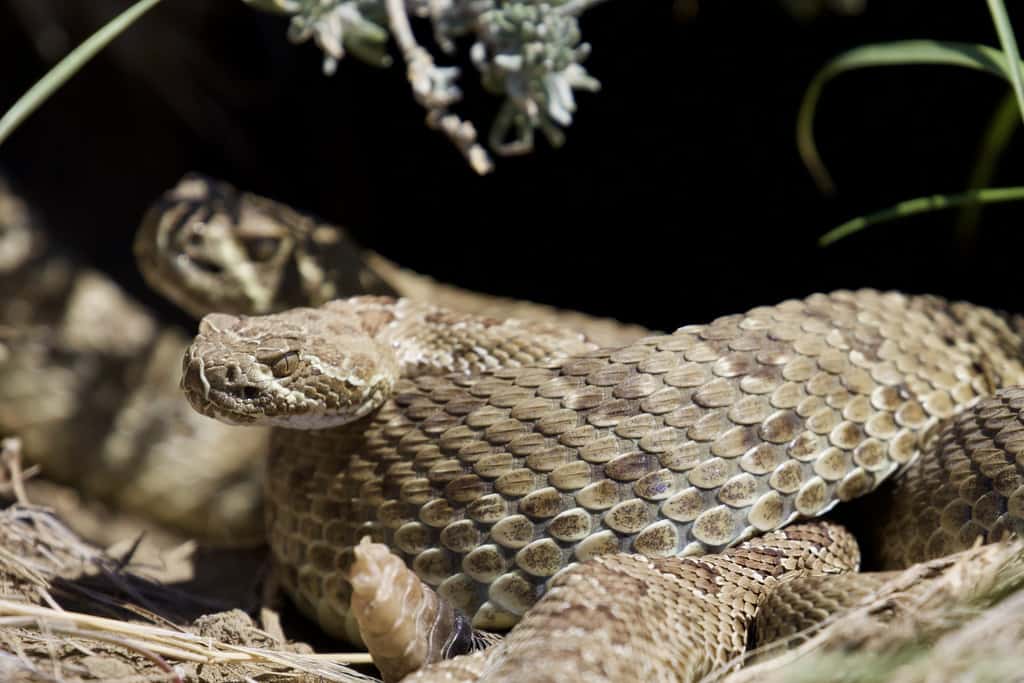
Maximum length: 151.5cm.
Defying their devilish reputation, the rattlesnake family might be the second most social. Not all species huddle together, but a large proportion do, particularly those in the western USA. The prairie rattlesnake is faithful to hibernation sites its whole life, returning to the same mammal burrows for decades. After journeying up to 20 miles to summer feeding grounds, they slither all the way back in November, and gather together with dozens, hundreds, or even thousands of fellow prairie rattlesnakes.
In 2020, for example, a project launched in Routt County, Colorado to record a prairie rattlesnake colony consisting of over 1000 individuals. These were crammed into a space just half the size of a tennis court, on private ranch land west of Elk Mountain (AKA Sleeping Giant).
The rattlesnakes assisted each other, as females would guard the snakelets of fellow mothers while they went on excursions underground. They would also leave the den at the same time to catch rainwater on their backs, which they then drank off each other. Prairie rattlesnakes can hibernate together in many spots, including vacant prairie dog holes, fissures in canyon walls, scree slopes, caves, or intricate underground burrow networks.
| 3 | Ring-necked snake |
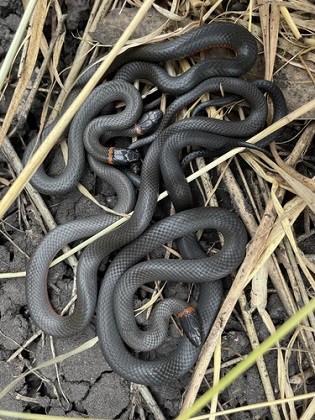
Maximum length: 85.7cm.
A snake of the southeastern USA. You can storm around the forest, pulling up old logs and tearing off pieces of rotting bark as you go, and find hundreds of ringneck snakes in an hour if you’re lucky.
This species measures just 30cm, and lives in forests, but also paths between them. They gather together not just during hibernation, but throughout the year. Ringneck necks feel uncomfortable when exposed, and instinctively gravitate towards shelter. With certain logs or mulch being optimal, this inevitably brings them into a huddle with fellow ringnecks.
For example, Henry Fitch once spent 30 minutes ripping up sheet metal on a hilltop in eastern Kansas. He managed to find 279 ringneck snakes. In Douglas County, Kansas, researchers Dundee and Miller discovered 300 in under an hour. Ring-necked snakes follow the scent trail of their fellow species members, which lingers on the forest floor. It only takes one ringneck snake to find a shelter, with others hot on its heels. Ring-necked snakes gather during hibernation, sometimes slithering hundreds of metres to find the optimal rocky crevice.
| 4 | Eastern brown snake |
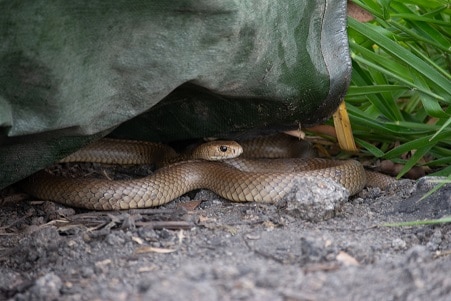
Maximum length: 240cm.
The second most venomous land snake in the world. Eastern brown snakes are growing more common in Australia, not less, thanks to agricultural sprawl which has created the perfect open habitat for them. There’s no need to huddle together for warmth in Australia, yet this species has many tales of communal gatherings.
In July 1991, a Mr Reeve was digging a trench at Melton airport 40km west of Sydney. As he scooped out a dirt block, he unearthed a secret underground hollow, where 6 adult eastern brown snakes were resting, measuring between 1.2 and 2 metres. It was winter, and the snakes were extremely lethargic.
In October 1976, Gary Stephenson found a den of 10 eastern brown snakes, 4 adults and 6 younglings, in a den in New South Wales. They were resting beneath a sheet metal of tin partially embedded in the ground. In autumn 1972, a resting group was found near a demolished house, beneath large slabs of concrete where the building had once stood. There were 13 eastern brown snakes, plus a blue-tongued skink lizard. After moving smaller concrete slabs nearby, Mr Webb found another 17 eastern brown snakes. Exactly why this species congregates is a mystery. They could be arriving at decent shelters independently of each other, or maybe there’s a secret snake code at play.
| 5 | Yellow-faced whipsnake |
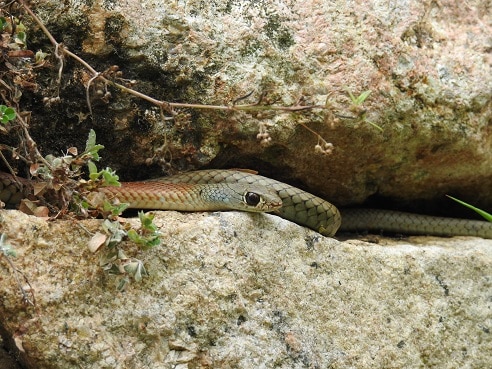
Maximum length: 100cm.
An Australian snake which is sometimes confused with eastern browns, but easily identifiable by their large round eyes. They have a mild venom, which mostly causes local swelling in human beings. Yellow-faced whipsnakes can be extremely common in suburbs, due to the abundance of skink lizards which they prey on. They’re quick to flee when threatened, dashing for cover, in which they happily nestle alongside other species members.
In Goodna, 9 were found lurking under one piece of plastic, with one eastern brown snake accompanying them. Likewise, 16 yellow-faced whipsnakes were once found on a single stone wall 3 metres high at Chapel Hill. In towns, they often lurk beneath mounds of litter, sheet metal, and timber piles.
Away from towns, 5 yellow-faced whipsnakes have been found resting together on a sandstone rock outcrop, and another 5 beneath sandstone rocks on top of a rocky hill near forest. Both batches were found in mid-winter, barely moving. Yellow-faced whipsnakes also lay their eggs communally, with 500-600 sometimes found in one hollow.
| 6 | Blackish blind snake |
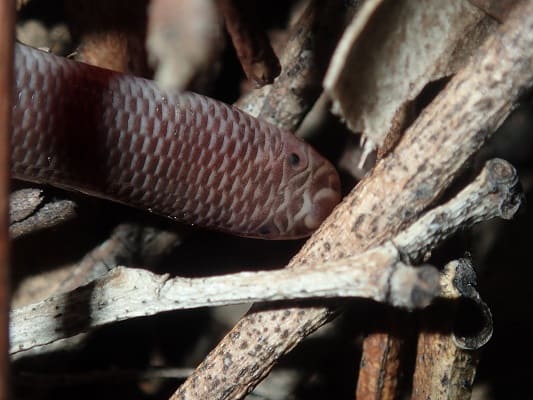
Maximum length: 75cm.
This burrowing snake closely resembles an earthworm, particularly given that it spends its life underground and is often spotted hanging from a bird’s beak. Blackish blind snakes (Anilios nigrescens) enlarge subterranean tunnels made by insects, and mostly prey on ants. It lives on Australia’s east coast, and has brown scales against a creamy bellow, with a maximum length of 60cm.
35 blackish blind snakes have been found resting together beneath sandstone rocks on a hillside. Another batch was found below a heavy log in dry, open woodland. A batch of 7 was found resting together on a valley floor, again below sandstone rocks. There were 6 adults and 1 youngling, and they tried to flee when the rock was ripped up.
With this snake, taking shelter makes more sense, as they live underground and probably require cooler conditions. Blackish blind snakes are harmless to humans, and renowned for their terrible eyesight. Their eyes look like the dots of a felt tip pin. However, blackish blind snakes are excellent at flecking their tongues to detect scents, and like the ringneck snake, this is probably how they gravitate towards each other.
| 7 | Common tree snake (Aus) |
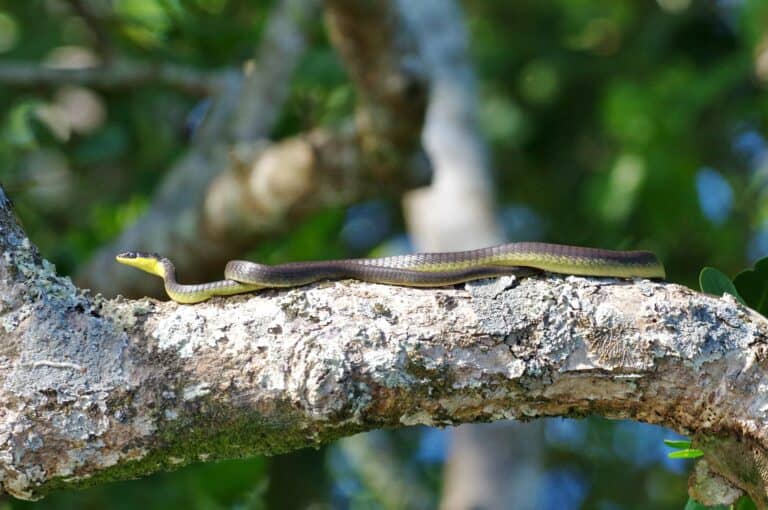
Maximum length: 164cm.
Australian snakes have a particular tendency to congregate for some reason, despite the various families diverging tens of millions of years ago. Dendrelaphis punctulatus differs from other communal snakes in that they hang out together not under rocks, but in trees.
This snake has excellent homing abilities, which allow it return to the same favourable vantage points annually, using scents and landmarks which guide them through bushland. They particularly like high branches disguised with leaves, which can be up to 25 metres above ground. In 2002, Brendan Schembri found 9 Dendrelaphis punctulatus resting on a small section of a forest red gum tree, with 4 occupying the same branch. He returned to the same tree every month after June 2002, and the congregating snakes always greeted him, beginning in March and ending in September.
In May 2005, the tree hosted 17 common tree snakes at once, and dozens of shed skins hung from the branches. This is fast, 1.5 metre, whiplike snake which is harmless to humans, and climbs trees as effortlessly as an escalator.
| 8 | Sharp-tailed snake |
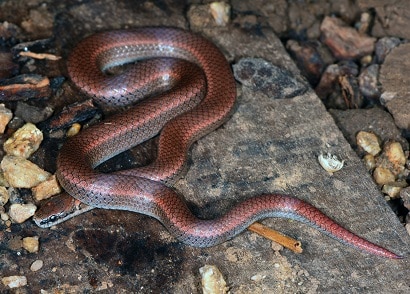
Maximum length: 48.3cm.
The northwest equivalent of the ring-necked snake. Sharp-tailed snakes (Contia tenuis) appear to be a total ripoff, as they’re also 30cm, also inhabit mulchy forests, and also hide beneath logs and rotting tree bark in groups of up to 20. More accurately, ring-necked snakes are far less common west of Texas, which leaves a vacant ecosystem niche in California, Washington and Oregon which this species fills instead.
Sharp-tailed snakes are harmless to humans except for their spiky tail. This is mostly designed for skewering slugs, but can cause a painful pinprick if you overconfidently pick them up. In California, 7 sharp-tailed snakes have been found resting under a pile of boards before. In Washington state, 22 were found together beneath cobblestones on a river embankment.
Their favourite spot to rest together is under rotting bark on fallen tree logs, where they craftily disguise themselves as millipedes, using an alternating black and white colour scheme on their belly. In the small areas where they overlap, sharp-tailed snakes have actually been found resting alongside ring-necked snakes.
| 9 | Queen snake |
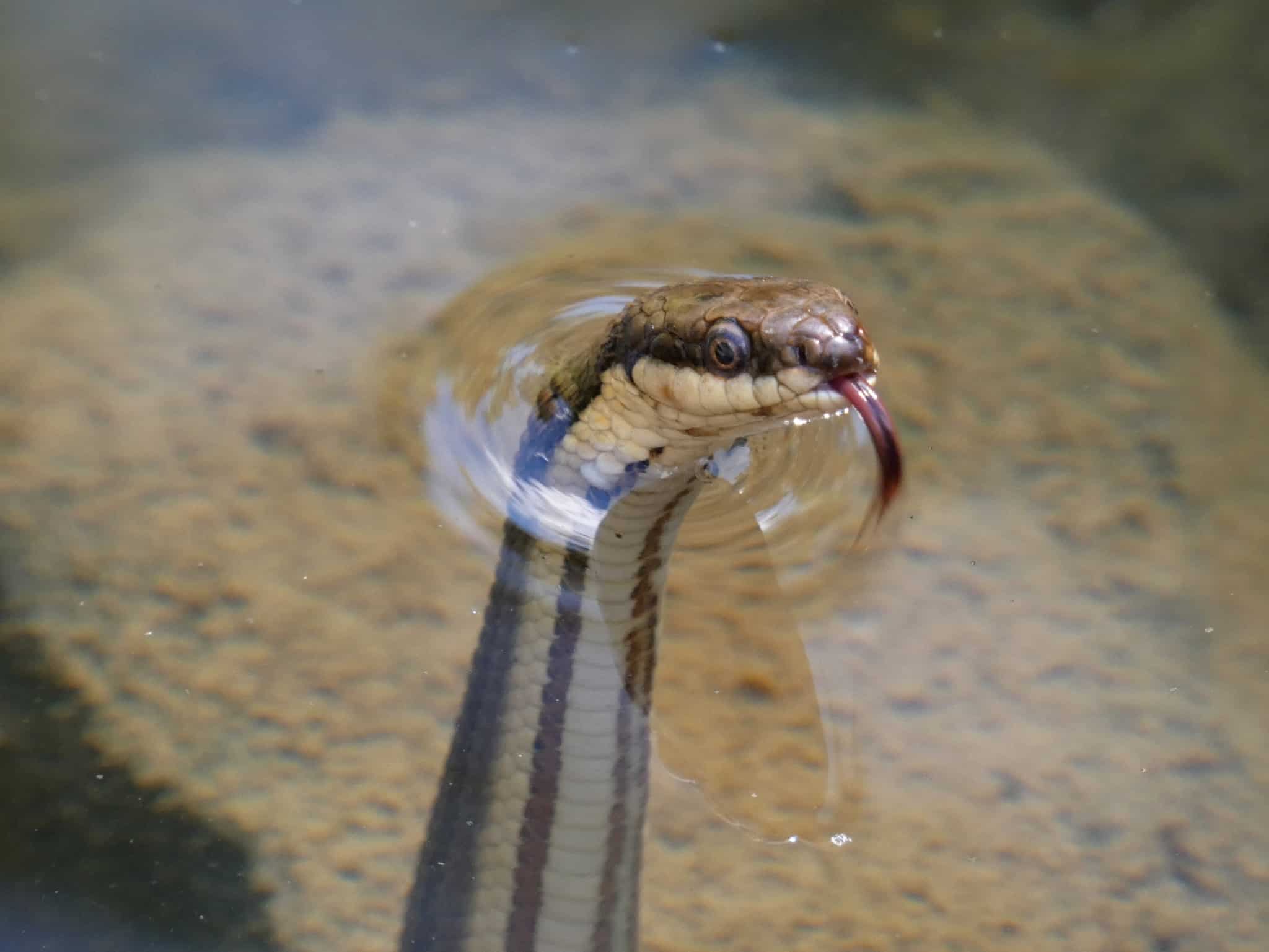
Maximum length: 94cm.
A river snake of the northern US, which preys on freshly molted crayfish, avoiding the hard-shelled adults which would break their teeth. Queen snakes have been witnessed congregating in huge numbers in their riverside homes. A Mr Neill spotted “dozens upon dozens” gathering together along a creek in Georgia, and believed that the entire population of the creek may have flocked together.
In October 1947, Mr Wood observed 47 queen snakes gathered on a single sapling tree overhanging the Miami river in Ohio. A 1946 survey from Ohio found 125 queen snakes in a 100 yard stretch of rocky creek, and 24 in one spot.
Scientists have unearthed 16 queen snakes lurking under a single limestone rock formation, and found 10 within a 6 metre stretch of riverbank on the Thames River near London (Ontario). While queen snakes might not be social exactly, they clearly don’t mind each other’s company. Unlike garter snakes, the exact purpose is unknown, but huddling for warmth is likely further north. Their hibernation dens include hollows in bedrock, old bridge abutments, and cracks in manmade dams.
| 10 | Arizona black rattlesnake |
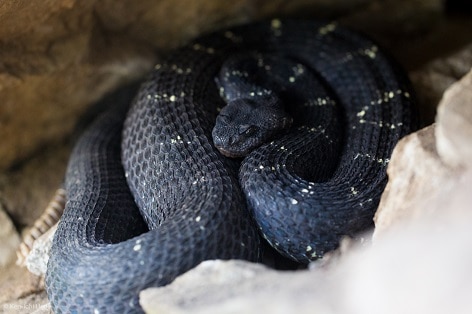
Maximum length: 88.5cm.
This rattlesnake lives solely in mountainous sky islands in Arizona, forested peaks which tower thousands of metres above the surrounding deserts. Originally, they were a prairie rattlesnake subspecies, before being split into their own species (Crotalus cerberus) in 2009. One feature they share is their communal lifestyle. In their rocky mountain forests, which are often near popular hiking trails, Arizona black rattlesnakes can gather in dark rocky crevices in their dozens, or even hundreds.
Mother snakes particularly cling to each other, and reside in the dens year round, not just during hibernation. Arizona black rattlesnakes seem to make friends, as they have fellow snakes which they strongly associate with, particularly as adults. They live in subgroups, which vary in size from 4, to several dozen.
The rattlesnakes had individual personalities, as a few preferred to stay alone. Adults will also form groups with younglings (for example, 2 adults and 2 hatchlings), which have probably evolved to advance the species. However, no mating takes place at these communal sites; they prefer secretive spots in the woods instead. Like prairie rattlesnakes, Crotalus cerberus mothers will entrust their hatchlings to fellow mothers while they leave the den on missions.
